Tekahionwake’s war party at Caledonia
May 26th, 2006 | By Randall White | Category: Key Current Issues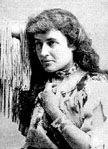 According to The Province in Vancouver: “A native group within the Vancouver area operating under the banner of the Six Nations Solidarity Network have been planning a response to see how they can support their Ontario native compatriots” in the Caledonia land-claim protest, which threatened fresh violence earlier this week.
According to The Province in Vancouver: “A native group within the Vancouver area operating under the banner of the Six Nations Solidarity Network have been planning a response to see how they can support their Ontario native compatriots” in the Caledonia land-claim protest, which threatened fresh violence earlier this week.
Just over 95 years ago, the same newspaper published the last writings of Pauline Johnson, a.k.a. Tekahionwake (“pronounced dageh-eeon-wageh”), who was born in 1861 on the Six Nations Grand River reserve in Ontario. She died in 1913 in Vancouver, where she was a close friend of Chief Joseph Capilano of the Central Coast Salish, and she still lies buried in Stanley Park.
Strangely enough, part of the very difficult and sad problem of the early 21st century Six Nations protest in Ontario is that Canada itself has largely forgotten the quite remarkable story of Pauline Johnson and Joseph Capilano in the early 20th century. It seems highly doubtful, e.g., that new federal Prime Minister Stephen Harper knows anything about it at all.
Yet aboriginal Canadians still do remember what non-aboriginal Canadians do not. And as the community newspaper in the legendary old multiracial fur trade wintering metropolis of Thunder Bay has astutely reported, Ontario provincial “Conservative Leader John Tory has been criticizing Premier McGuinty and Native Affairs Minister David Ramsay for not visiting with the protestors. But the native leaders say it’s not the premier, but the prime minister, who must help resolve the issue.”
What is the real issue in Caledonia anyway?
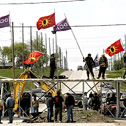 What really is the issue here, some will reasonably enough ask? And there is little doubt that the patience of the non-aboriginal community – in the Caledonia area and in Ontario at large – is wearing thin.
What really is the issue here, some will reasonably enough ask? And there is little doubt that the patience of the non-aboriginal community – in the Caledonia area and in Ontario at large – is wearing thin.
As explained in a recent Toronto Globe and Mail report, the Six Nations protesters have been occupying the site of a modest new housing development, under construction in Caledonia, about 25 kilometres south of Hamilton, since late February. They “argue that the site was part of a large land grant in 1784. The provincial and federal governments say the land was surrendered in 1841 to help build a major highway.”
In April “Ontario Provincial Police staged a pre-dawn raid on the site in an effort to remove the protesters after a court injunction ordered that they disperse.” This raised tensions without actually removing the protesters, who then took to blocking a local highway. Subsequent discussions mediated by former Ontario premier David Peterson seemed to make progress, but the pace was agonizingly slow. Most recently, tensions have been inflamed again by frustrated non-aboriginal residents of Caledonia, who set up their own road blockade against the protesters. This prompted further retaliation, which led to the toppling of a local hydro tower. This apparently led to an electric power outage in the area, which has just now been repaired. [UPDATE: See correction in comments below. It appears that the power outage was caused by a truck burning near a transformer station, not by the toppled local hydro tower.]
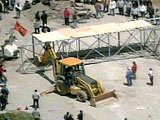 As matters stand, further mediation efforts by Mr. Peterson and aboriginal leaders have restored some order. The road blockades on both sides have been lifted. But the Six Nations protesters continue to occupy the construction site. Ordinary life in Caledonia has not returned to normal, for both aboriginal and non-aboriginal residents. A recent Globe and Mail online edition opinion poll found 58% of more than 23,000 respondents answering Yes to the question “Do you believe the government should use force to end the native protest in Caledonia, Ontario?”
As matters stand, further mediation efforts by Mr. Peterson and aboriginal leaders have restored some order. The road blockades on both sides have been lifted. But the Six Nations protesters continue to occupy the construction site. Ordinary life in Caledonia has not returned to normal, for both aboriginal and non-aboriginal residents. A recent Globe and Mail online edition opinion poll found 58% of more than 23,000 respondents answering Yes to the question “Do you believe the government should use force to end the native protest in Caledonia, Ontario?”
The question that ultimately seems to puzzle many non-aboriginal Canadians, in Ontario and elsewhere, is why the comparatively small parcel of land taken up by the construction site is suddenly so important to the Six Nations of the Grand River Territory?
As a Six Nations website explains, their original 1784 land grant from the British Crown – awarded in gratitude for Six Nations loyalty and aid to the Crown in the American War of Independence – involved “a tract of land six miles on each side of the Grand River” (which runs down to Lake Erie). But: “Over the years much of the original 950,000 acres has been leased, sold, or taken, and only … 46,500 acres remain.” The construction site near Caledonia currently being occupied, whatever the exact legalities of its mid 19th century alienation may be, is only 40 hectares. Why is it now so crucial?
What happened to the Kelowna Accord?
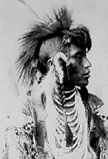 One conceivable quite concrete answer to this question has as yet been little discussed in the mass media. And, even if it is at least closer to the real central issue, it has not been at all clearly and explicitly singled out by Six Nations and other aboriginal leaders either.
One conceivable quite concrete answer to this question has as yet been little discussed in the mass media. And, even if it is at least closer to the real central issue, it has not been at all clearly and explicitly singled out by Six Nations and other aboriginal leaders either.
Across the country many among what section 35 of Pierre Trudeau’s new Constitution Act 1982 calls “the aboriginal peoples of Canada” have been perturbed by a new harsher attitude towards aboriginal issues signaled by the election of the Harper Conservative minority government this past January 23.
Some people keep asking: just what did Paul Martin’s previous Liberal minority government accomplish during its 18 months in office? One answer is the so-called Kelowna Accord on aboriginal issues, negotiated by government and aboriginal leaders in Kelowna, BC at the end of this past November 2005. It no doubt was far from perfect. But it was at least a fresh start on longstanding problems of aboriginal policy in Canada, based on some degree of consensus among aboriginal and non-aboriginal leaders.
As the current Liberal Party of Canada website laments, the new Harper Conservative minority government has turned its back on the Kelowna Accord. E.g. (from May 24): “Liberal Indian Affairs Critic Anita Neville [Winnipeg South Centre] today called on the Federal Government to commit to maintaining the Procurement Strategy for Aboriginal Business (PSAB), which the Conservative government is undermining by opening up bidding to non-Aboriginal companies … Beginning with this government’s abandonment of the Kelowna Accord and continuing onward we can now add this to the list of examples of the Harper government neglecting Canada’s Aboriginal people’… ”
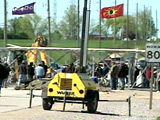 Setting aside the crass partisan politics, there is something here that does get at what the Thunder Bay community newspaper was recently alluding to, when it astutely reported that “the native leaders” in the Caledonia area “say it’s not the premier, but the prime minister, who must help resolve the issue.”
Setting aside the crass partisan politics, there is something here that does get at what the Thunder Bay community newspaper was recently alluding to, when it astutely reported that “the native leaders” in the Caledonia area “say it’s not the premier, but the prime minister, who must help resolve the issue.”
All this would be clearer if aboriginal leaders themselves were to say that the ultimate underlying issue behind the so-called Caledonia land-claim protest in Ontario is the Harper government’s abandonment of the Kelowna Accord. But for them, it seems, this is only half true, at best. Aboriginal politics in Canada are deeply complicated, on many different fronts.
At the same time, the issues at the bottom of the Caledonia protest do seem to relate finally to the federal government in Ottawa – as the ultimate effective present-day representative of the old British Crown (which granted the Grand River territory to the Six Nations in the first place), and its sovereign successor, so to speak, the democratic Canadian people. As assorted signs and placards the protesters have waved suggest, their problem is with “Canada.” Aboriginal peoples in other parts of the country have seen things this way too. There have already been Ontario Six Nations sympathy protests on the Lions Gate bridge in Vancouver, e.g., and on the Yellowhead Highway near North Battleford in Saskatchewan.
The protest at Caledonia began some three months ago now. And it is intriguing that on the same day the Caledonia construction site was first occupied – February 28, 2006 – the Grassy Narrows First Nation far away in the wilds of northern Ontario also “sent letters warning the chief executives of Weyerhaeuser … and Abitibi-Consolidated to immediately cease and desist from all logging and industrial resource extraction on our territory’.” Something had happened by this point to prompt such stiffening of aboriginal feelings on long-standing grievances. And it is easy enough to speculate that the settling in of the new Harper government had something to do with it. As if the aboriginal peoples of Canada are looking for some kind of reassurance from the new regime in Ottawa that their recent progress is not about to be abandoned altogether.
Illusions of aboriginal sovereignty …
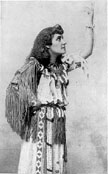 As the latest issue of the influential Ontario government and politics newsletter Inside Queen’s Park has put it, the increasing local aboriginal-non-aboriginal tension surrounding the Caledonia protest “suggests that can’t we all just get along’ won’t cut it” any longer.
As the latest issue of the influential Ontario government and politics newsletter Inside Queen’s Park has put it, the increasing local aboriginal-non-aboriginal tension surrounding the Caledonia protest “suggests that can’t we all just get along’ won’t cut it” any longer.
The Toronto Globe and Mail columnist John Ibbitson has also just written a quite gloomily tough-minded column on the issue: “Because there are such large reservoirs of goodwill, even now, mediators can often negotiate truces, and there was hope yesterday that an uneasy peace would come to Caledonia. We can’t know how long it will hold, or where or when the next barricade will go up … Can we prevent more barricades? No. We and those who came before us created this mess, and we and those who come after us will have to live with it. Maybe, one day, federal and provincial governments will put some muscle and energy behind resolving land claims; maybe the native leadership will accept that this war will never be fully won, that new treaties with teeth are better than ancient claims … But before any of that happens, there will be more Caledonias, probably many more. The best we can hope for, although it’s not realistic, is that no one gets killed.”
As in other contexts, it would seem, the Harper government’s new harsher attitude to aboriginal issues generally both reflects and no doubt helps promote such unhappy feelings, among both non-aboriginal and aboriginal Canadians. And it is no doubt true enough that not all the blame for the current impasse rests with non-aboriginal Canadians.
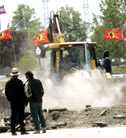 For more than a generation now, certain excesses of cultural post-modernism, or something of that sort, along with the example of Quebec (and such non-aboriginal leaders as the current premiers of Alberta and Newfoundland?), have encouraged aboriginal leaders to focus their grievances around wildly unrealistic claims about first nations sovereignty in Canada today. The public assertions of some Six Nations spokespersons at Caledonia about wanting to deal with the governor general – as the current local representative of the British Crown – have only been the latest bizarre cases in point.
For more than a generation now, certain excesses of cultural post-modernism, or something of that sort, along with the example of Quebec (and such non-aboriginal leaders as the current premiers of Alberta and Newfoundland?), have encouraged aboriginal leaders to focus their grievances around wildly unrealistic claims about first nations sovereignty in Canada today. The public assertions of some Six Nations spokespersons at Caledonia about wanting to deal with the governor general – as the current local representative of the British Crown – have only been the latest bizarre cases in point.
Ironically, the Kelowna Accord negotiated last November marked an encouraging fresh point of departure from this kind of dysfunctional aboriginal sovereigntist syndrome. It at least tried to focus on promoting concrete improvements in the lamentable social and economic circumstances of all too many aboriginal peoples of Canada today – while at the same time continuing to show respect for what section 35 of the Constitution Act 1982 calls the “existing aboriginal and treaty rights of the aboriginal peoples of Canada.”
The new Harper Conservatives have not been willing to just pick up and carry on with the Kelowna Accord. It seems not easy to say just why, without straying onto very thorny paths through the forest. And it would of course be too rash to suggest that if they had, the Six Nations land-claim protest in Caledonia would never have started on February 28, 2006. But it does seem arguable enough that if they had, the new era of aboriginal-non-aboriginal bitterness that John Ibbitson’s gloomy assessment suggests now lies before us might not loom quite so darkly.
The sad lost opportunities of Tekahionwake’s Legends of Vancouver …
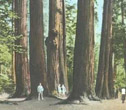 All this is especially sad, because Canada actually does have a different kind of historical tradition, somewhere out there in the apparently almost now completely lost mists of time. And this tradition conceivably could serve as a more forward-looking and optimistic foundation for dealing more effectively with the continuing troubles of both the aboriginal peoples of Canada and their non-aboriginal fellow Canadians, coast to coast to coast.
All this is especially sad, because Canada actually does have a different kind of historical tradition, somewhere out there in the apparently almost now completely lost mists of time. And this tradition conceivably could serve as a more forward-looking and optimistic foundation for dealing more effectively with the continuing troubles of both the aboriginal peoples of Canada and their non-aboriginal fellow Canadians, coast to coast to coast.
This is what makes the quite remarkable early 20th century story of the Six Nations Iroquois poet Pauline Johnson, and her Coast Salish friend Chief Joseph Capilano, still quite interesting a century later. It would take a short book, at least, to go into the details. But a few brief hints might suggest the larger argument.
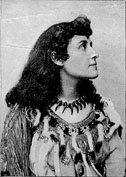 The modern transcontinental Canada that has its deepest roots in the 17th, 18th, and earlier 19th centuries arose around the expansion of the “Indian-European” fur trade in the unique geography of “northern North America.” It leaned on an extensive collaboration between aboriginal peoples and European merchants and adventurers (and assorted peoples of African and even Asian descent as well). Pauline Johnson was an ultimate creation of this collaboration, who achieved some fame in the late 19th and earlier 20th centuries, before the old tradition had virtually vanished, as it sadly has now – almost if not quite completely.
The modern transcontinental Canada that has its deepest roots in the 17th, 18th, and earlier 19th centuries arose around the expansion of the “Indian-European” fur trade in the unique geography of “northern North America.” It leaned on an extensive collaboration between aboriginal peoples and European merchants and adventurers (and assorted peoples of African and even Asian descent as well). Pauline Johnson was an ultimate creation of this collaboration, who achieved some fame in the late 19th and earlier 20th centuries, before the old tradition had virtually vanished, as it sadly has now – almost if not quite completely.
A very short account of her life on the McMaster University Pauline Johnson Archive website summarizes her story: “Emily Pauline Johnson was one of Canada’s most popular and successful entertainers at the turn-of-the-century. The daughter of a Mohawk Native-Canadian father and an English mother, Pauline Johnson used the Mohawk name Tekahionwake’. Then, at the age of 31 when her society expected her to marry and have children, she began to tour the country. She gave popular recitals of her poetry, comedy routines and plays from Halifax to Vancouver. She was the first Native poet to have her work published in Canada. She was … proud of her Native heritage and wrote that My aim, my joy, my pride is to sing the glories of my own people.'”
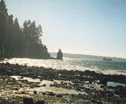 Though born and raised in Ontario, Pauline Johnson ended her life in British Columbia. And another website summarizes this part of her story: “In 1906 Pauline travelled to London, England, where she first met Chief Joseph Capilano of the Squohomish or ‘Squamish’ band of Central Coast Salish Indians who lived north of Vancouver at the head of Howe Sound in British Columbia. Chief Capilano and two fellow Salish chiefs had voyaged to England – the first West Coast native chiefs to do so – to protest violations of their treaty land and game rights to King Edward VII. Pauline not only befriended Chief Joe’ but also assisted in gaining a royal audience for him. When she retired from the stage in 1909, she settled in Vancouver where she renewed her acquaintance with her tillicum skookum’ or great friend Joseph Capilano. During long visits and canoe rides, he told her the tales of Salish culture she was to re-tell in Legends of Vancouver” (her last book, published not long before she died).
Though born and raised in Ontario, Pauline Johnson ended her life in British Columbia. And another website summarizes this part of her story: “In 1906 Pauline travelled to London, England, where she first met Chief Joseph Capilano of the Squohomish or ‘Squamish’ band of Central Coast Salish Indians who lived north of Vancouver at the head of Howe Sound in British Columbia. Chief Capilano and two fellow Salish chiefs had voyaged to England – the first West Coast native chiefs to do so – to protest violations of their treaty land and game rights to King Edward VII. Pauline not only befriended Chief Joe’ but also assisted in gaining a royal audience for him. When she retired from the stage in 1909, she settled in Vancouver where she renewed her acquaintance with her tillicum skookum’ or great friend Joseph Capilano. During long visits and canoe rides, he told her the tales of Salish culture she was to re-tell in Legends of Vancouver” (her last book, published not long before she died).
The early 20th century story of the Six Nations Iroquois poet Pauline Johnson, and her Coast Salish friend Chief Joseph Capilano, also ought to be reminding Canadians today of a passage from the conclusion of the economist Harold Innis’s Canadian historical classic, The Fur Trade in Canada: An Introduction to Canadian Economic History, first published in 1930 (and still very much in print for at least some university students): “We have not yet realized that the Indian and his culture were fundamental to the growth of Canadian institutions.”
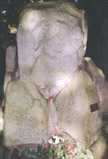 In the last half of the 20th century what the new Harper Conservative government’s first throne speech of this past April celebrated several times as “the Canadian people” gradually took over the ultimate sovereign power in modern Canada from the old British Crown. But despite the exhortations in section 35 of the Constitution Act 1982, “we” have still not quite realized that the story of the modern Canadian people begins with “the aboriginal peoples of Canada.”
In the last half of the 20th century what the new Harper Conservative government’s first throne speech of this past April celebrated several times as “the Canadian people” gradually took over the ultimate sovereign power in modern Canada from the old British Crown. But despite the exhortations in section 35 of the Constitution Act 1982, “we” have still not quite realized that the story of the modern Canadian people begins with “the aboriginal peoples of Canada.”
When we finally do realize this, we will probably have a little less trouble with such things as the current Six Nations land-claim protest in Caledonia, Ontario. Arcane native land claims, that is to say, may seem somewhat less important when the aboriginal peoples of Canada finally have what most of them seem to want most – some proper and practical respect and recognition for their historically quite important role in building Canada as we know it today.
It is, arguably enough, one of the responsibilities of the federal government in Ottawa to try to help us understand all this. And it is not crass partisan politics to suggest that, whatever all its other faults may or may not have been, Paul Martin’s short-lived Liberal minority government had somewhat stronger instincts about this responsibility than Stephen Harper’s current Conservative minority government.
(Meanwhile, it is encouraging to notice that, as the sympathy protests for the Six Nations in Ontario from aboriginal peoples of Canada in British Columbia, Saskatchewan, and other parts of the country suggest, at least the original first nations of the modern Canadian people are already grown up enough to understand the importance of working all together, coast to coast to coast. Which is, alas, more than many non-aboriginal peoples of Canada seem to appreciate these days.)
Randall White is the author of a number of books, including Ontario 1610-1985: A Political and Economic History and Is Canada Trapped in a Time Warp?: Political Symbols in the Age of the Internet.
The photographs of Pauline Johnson here have been taken from the McMaster University Pauline Johnson Archive.

